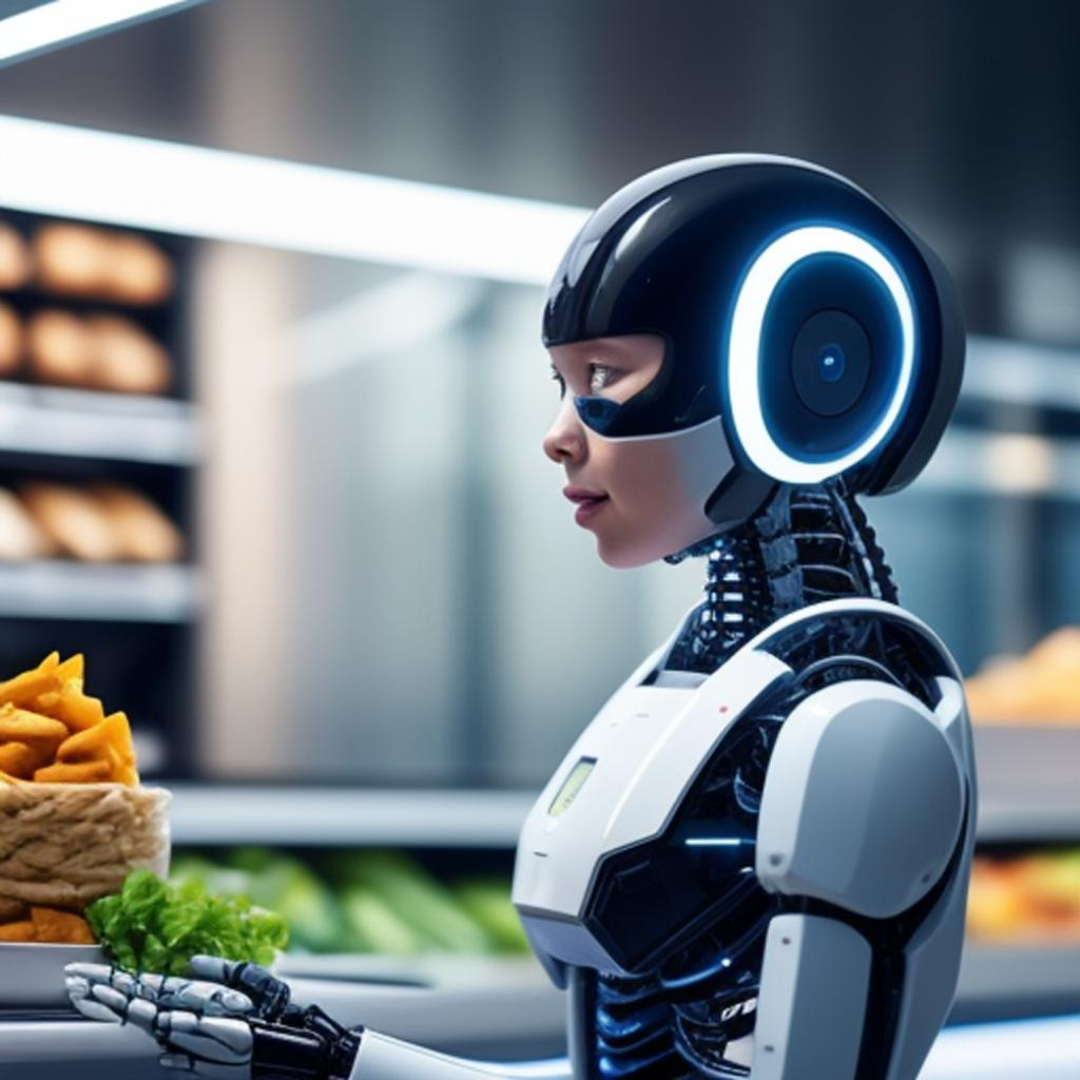The future of artificial intelligence in the food industry holds promise for revolutionizing production, distribution, and consumption processes. Indeed, artificial intelligence (AI) is transforming many sectors of the economy, including the food business, and has become a necessary component of daily life. Let’s examine its possible advantages as well as the worries about its effects:
Advantages of Artificial Intelligence in the Food Industry
1. Efficiency and Cost Reduction: AI optimizes operations, resulting in increased food production, supply chain management, logistical efficiency, and lower costs.
2. Quality Control: AI systems are capable of evaluating food quality, identifying flaws, and guaranteeing uniform standards.
3. Personalized Nutrition: AI systems assess each person’s unique nutritional requirements and provide customized meal plans.
4. Food Safety: Artificial intelligence keeps an eye on food safety by anticipating spoilage, identifying impurities, and guaranteeing adherence to rules.
5. Sustainable Agriculture: AI helps with precision farming, maximizing resource use, and reducing environmental negative effects.
Concerns and Risks
1. Bias and Fairness: AI systems may carry over biases from training data, which may have an impact on choices about hiring, access, and the distribution of food.
2. Job Displacement: Automation may result in employment losses in the delivery and processing of food.
3. Data security and privacy: Since AI depends on data, customer information has privacy issues.
4. Ethical Dilemmas: AI-made decisions, like food restrictions, may present moral quandaries.
5. Unintended Consequences: The intricacy of AI might have unanticipated effects that affect the cost and availability of food.
How Artificial intelligence (AI) is being used in the food production industry
1. Food Sorting: It takes time to sort fresh produce according to its size, color, and quality. TOMRA Sorting Food develops AI-driven optical sorting systems that replicate human vision using cameras and near-infrared sensors. These technologies increase yields, lower the need for human sorting, and improve quality overall.
2. Chain of Supply Management:
AI supports supply chain management in several ways, including:
Monitoring food safety: guaranteeing product safety across the whole supply chain.
Accurate Forecasting: Precise forecasting leads to improved inventory control and pricing.
Product Tracking: Transparency from farm to customer is ensured through Product Tracking.
Personal Hygiene Compliance: Using object and face recognition algorithms to track employees’ compliance with safety rules
3. Creating New Products: Gastrograph AI models customer flavor preferences with machine learning and prediction algorithms. It supports product development by assisting food firms in forecasting how well new flavors would appeal to certain demographic groups.
4. Equipment for Cleaning and Processing: There will soon be AI-driven cleaning and maintenance solutions for processing equipment, which should increase productivity and decrease downtime.
How does AI improve food safety?
The integration of artificial intelligence (AI) is crucial in improving food safety across the food manufacturing and distribution process. AI enhances food safety in the following ways:
1. Inspection and Quality Control: Vision on Computers: Food items can have flaws, pollutants, and anomalies detected during manufacturing and packaging by AI-powered systems. For quality assurance, visual data undergoes analysis by cameras and sensors.
Sorting and Grading: By reducing human error and enhancing uniformity, AI algorithms sort fruits, vegetables, and other products according to size, color, and quality.
2. Predictive analytics: AI algorithms forecast safety hazards, shelf life, and food deterioration. Through the examination of past data, they offer early alerts that facilitate prompt responses.
3. Supply Chain Management: AI makes supply chains more efficient by keeping track of inventories, keeping an eye on traffic conditions, and guaranteeing that safety rules are followed.
Traceability: AI systems based on blockchain technology facilitate transparent tracking of food products from farm to table, enhancing accountability.
4. Foodborne Pathogen Detection: AI finds dangerous pathogens in food samples, such as bacteria and viruses. Rapid testing and genetic analysis are two methods. Early Outbreak Detection: To stop widespread contamination, AI watches for patterns and notifies authorities of possible outbreaks.
5. Personalized Nutrition: AI examines nutritional requirements, dietary preferences, and allergies for each individual. It promotes safety and health by suggesting wholesome eating options.
6. Real-time Monitoring: Sensors and Internet of Things devices gather information on temperature, humidity, and storage conditions.
How can AI prevent foodborne illnesses?
To avoid foodborne infections, artificial intelligence (AI) is essential. It helps ensure the safety of food in the following ways:
1. Pathogen Detection: Artificial intelligence methods, such as optical imaging, can detect germs in food with speed and precision. Early detection of pathogenic microbes allows us to stop outbreaks and diseases.
2. Food Sorting: AI-powered algorithms classify food by size, shape, and color. This lowers the possibility of contamination by guaranteeing that only safe products reach customers.
3. Supply Chain Monitoring: AI follows food from farm to table to make sure safety rules are followed. It finds irregularities and aids in removing tainted goods from circulation.
4. Predictive analytics: AI algorithms forecast safety concerns, shelf life, and spoilage. Prompt alerts enable prompt remedial action.
5. Personalized Nutrition: AI assesses each person’s nutritional requirements,
How can AI improve food traceability?
Food traceability is greatly improved by artificial intelligence (AI), assuring transparency and safety throughout the supply chain. Here are a few methods AI uses to do this:
Real-Time Tracking: AI in real-time enables accurate tracking from farm to table. Accurate information about origin, handling, and transportation is ensured via real-time data collection.
2. Data Analysis: AI analyzes enormous volumes of data to find trends and abnormalities. It aids in the detection of anomalies like temperature changes or veering off of planned itineraries.
3. Predictive Insights: AI forecasts possible dangers by examining past data. It can foresee spoiling, contamination, or interruptions in the supply chain, for instance.
4. Automation and Error Reduction: AI reduces human error by automating operations like inventory management. Accuracy is improved via blockchain technology, RFID tags, and barcode scanning.
